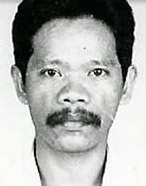 |
||
|---|---|---|
| CP Foundation | About CP Biennale | 2003 | 2005 | Contact Us | >||
           
|
||
|
An artist's creative process resembles a work whose ending and final result remain unpredictable. The sensitivity of the artist working with the material eventually dictates when the process ends. Ali Umar calls this process as "playing," a common phenomenon with artists who find enjoyment in working with a particular material. Some might find such intuitive work difficult to understand in the rationalistic mind frame of art. As the media for the artist's idea to find its physical form, the materials work under certain conventions. Such conventions are known under various names: monolithic and installative (referring to the spatial aspect); miniatures and monumental (referring to the size of the work); abstractive and figurative (referring to the visualization aspect); or formal and representational (referring to the ideological aspect). Artists whose works are essentially based on the material itself usually ignore such conventions. There is a distinct difference between a sculptor and an artist-craftsman. Sculptors free themselves from the choices of the materials and dwell more on the spatial, dimensional, visual, and ideological conventions. Artist-craftsmen, on the other hand, confine themselves with a particular material and are free from the conventions found in sculpting, and even from the categorical conventions such as whether the work will result in a ready-to-wear object, an aesthetic element, or a work of art. Ali Umar is going through a period when he finds his enjoyment in working with wood. Many of his works are small things, arranged on the wall, lie on the floor, stand on a base, or hang from the ceiling. Organic forms, wooden patterns, smooth surfaces (so smooth they often shine) are the visual hallmarks of Ali Umar's works. He finds it important that his works still display the remnants of what he does to them--all the cutting, sharpening, scratching, and rubbing. Ali Umar's experience as a sculptor and his awareness about the potentials of the materials enable him to work comfortably with his chosen material for his representational interests. In his works, his treatments to the material, which make certain characters of the material become more remarkable, are combined with representations of human body parts. The final image forms a bissociation with the two matters. Naturally, which convention the artist follows no longer matters here, as it becomes the historical aspect of the artist, enabling us to recognize how an idea finds its form. In Ali Umar's case, his intention to convey a message and his attitude towards the material becomes the base to understand his works. Nurdian Ichsan Born on 1967 in Padang, West Sumatra. SELECTED SOLO EXHIBITIONS SELECTED GROUP EXHIBITIONS |
||
|
CP Foundation | About CP Biennale | 2003 | 2005 | Contact Us
Jl. Suryopranoto 67A, Jakarta 10160, Indonesia. ph. +62.21.3448126, 3853206 | fax. +62.21.3853203, 3853208 info@cp-foundation.org |
||
 Materials do not merely submit to the will of the artist, they have their own essential characters. The phrase "the truth of the material," commonly heard in discourses on craft, refers to this phenomenon. It conveys the artists' faith in the essential character of the material. Artist-craftsman is not the only one who is especially familiar with materials; Ali Umar, whose background is actually in sculpting, is an example of an artist who masters the material he works with. Wood in Ali Umar's works is a material that represents itself.
Materials do not merely submit to the will of the artist, they have their own essential characters. The phrase "the truth of the material," commonly heard in discourses on craft, refers to this phenomenon. It conveys the artists' faith in the essential character of the material. Artist-craftsman is not the only one who is especially familiar with materials; Ali Umar, whose background is actually in sculpting, is an example of an artist who masters the material he works with. Wood in Ali Umar's works is a material that represents itself.